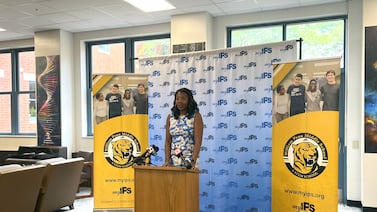Sign up for Chalkbeat’s free weekly newsletter to keep up with how education is changing across the U.S.
Many students breathed a sigh of relief last week when federal education officials announced critical fixes to the federal application for financial aid that allows parents without Social Security numbers to contribute information to the form.
The change means tens of thousands of U.S. citizen students and others who are eligible for federal financial aid can finally complete their FAFSAs. But it also leaves families and college counselors scrambling to get through the process months after other students. And some families are still encountering problems.
“It can be very discouraging for students and families who feel like they’re doing all the right things and yet are still coming up against barriers,” said Amanda Seider, who oversees the Massachusetts branch of the college access group OneGoal.
Chalkbeat reported in January that a technical glitch had blocked students with undocumented parents from completing their financial aid applications for over two months. That left many educators and college access groups worried that students who already face higher barriers to college would be deterred by the delays — piled on top of an already difficult rollout of the new, supposedly easier FAFSA. Some colleges and scholarships award aid on a first-come, first-served basis, so students who apply later are at a disadvantage.
During that time, students were left to navigate a confusing array of options, including whether they should just sit tight and wait for a fix, or try a partial workaround that could put them at a higher risk of making a mistake on their application or would require them to come back and fill out more paperwork later.
And there are still outstanding issues. As federal officials put the new fix in place, they uncovered two more issues affecting the same group of students that still need to be resolved.
That means parents without Social Security numbers will have to enter their financial information manually, instead of having it pulled directly from the IRS. And in some cases — when a parent enters a name or address that doesn’t exactly match what their child put down, for example — parents are still getting error messages that block them from filling out the form. Federal officials said last week they would work to fix the issue “in the coming days.”
Federal officials estimated that around 2% of financial aid applicants were affected by the original Social Security number glitch, which would equate to hundreds of thousands of students in a typical year.
The issue caught the attention of dozens of Democratic House members, who sent a letter to U.S. Secretary of Education Miguel Cardona urging the department to fix the problem quickly. In a press release issued last week, U.S. Rep. Jared Huffman of California said the glitch was a “completely unacceptable error” that had caused “fear, stress, and missed opportunities for many kids across my district and the country.”
“I hope to see the Department take the steps necessary to ensure issues like this never arise again,” Huffman said.
The rollout of the new FAFSA has been riddled with problems and delays. Education department officials have blamed insufficient funding and significant technical challenges in updating old systems. Republicans have accused the administration of being distracted by dealing with student loan forgiveness. Outside observers have said all these factors and more played a role, according to news reports.
FAFSA applications are down 33% compared with this time last year, according to federal data tracked by the National College Attainment Network.
In the meantime, many colleges have pushed back deadlines as they wait for student financial information that will help them assemble aid packages. And families are waiting.
Now, college counselors and advisers say they’re working to make sure students know what to do if they continue to encounter glitches. They’re also trying to keep students’ spirits up and getting them ready to compare their financial aid and acceptance packages when they come in.
“The most important thing we can do is to share information about how to go about entering information manually, how to make sure that as they are completing those steps that it requires a lot of precision,” Seider said. “We really want to make sure that students and families are being proactive, and not experiencing this as their shortcoming, but rather saying ‘Hey, this system has been a little confusing, we need some help with it.’”
Kalyn Belsha is a senior national education reporter based in Chicago. Contact her at kbelsha@chalkbeat.org.







